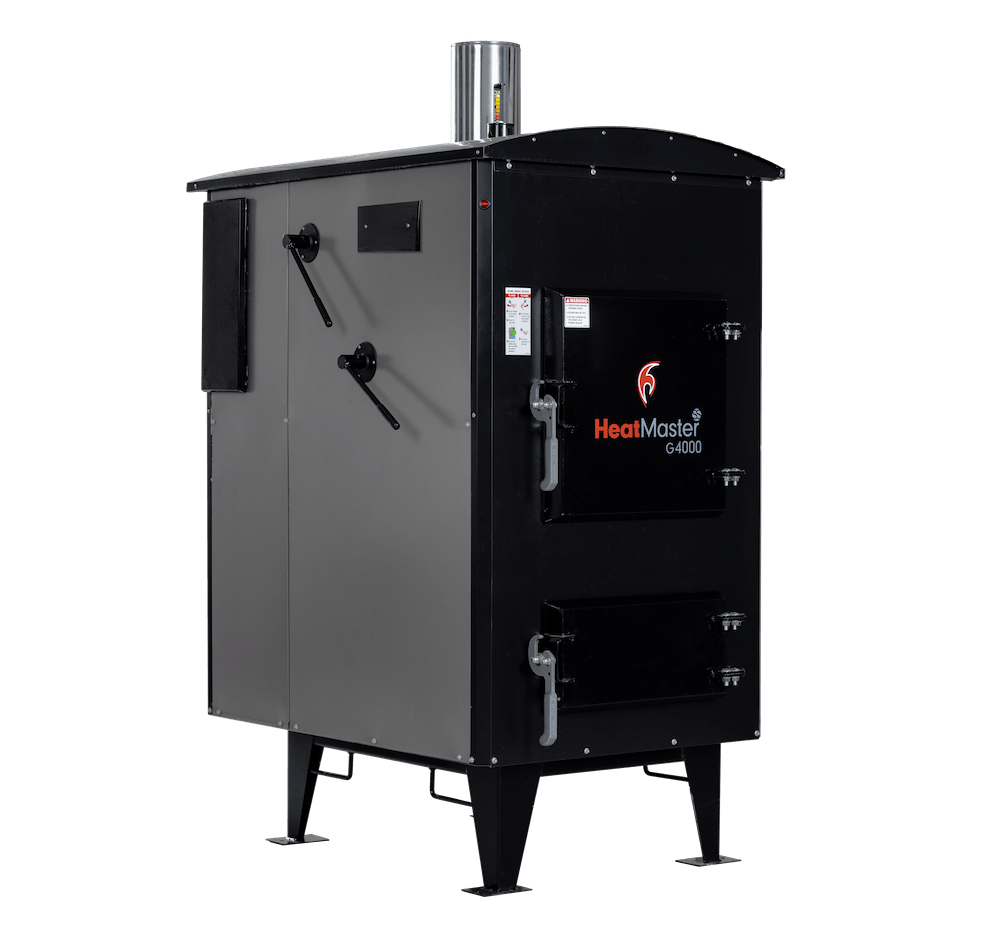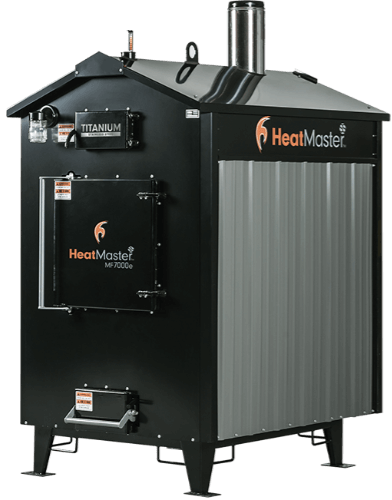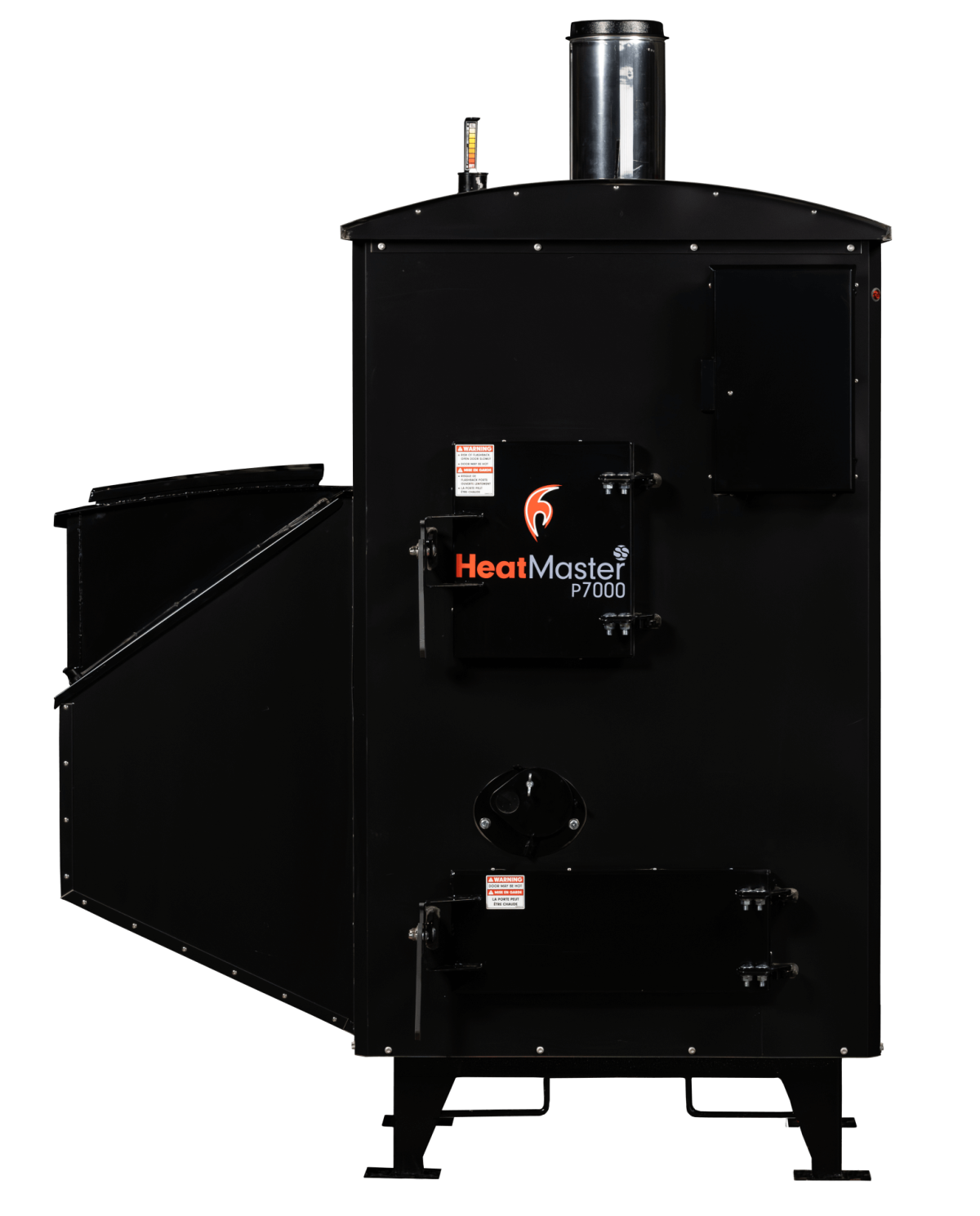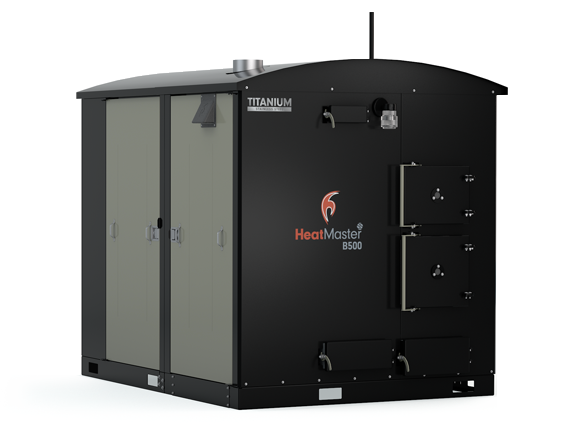Cleaning & Maintenance Guide For Your HeatMasterss G Series Outdoor Furnace
If you have a G Series outdoor wood furnace it’s critical to clean it regularly and to do a deep cleaning at the end of the burning season. Not cleaning your furnace can lead to a number of problems, including decreased efficiency and increased emissions. In this article, we’ll discuss the best way to clean your G Series outdoor wood furnace.
Why Clean Your Outdoor Furnace
You made a big investment in your outdoor boiler system and it can last decades, but only if you stay vigilant with a few simple maintenance items. At HeatMasterss we use corrosion-resistant Titanium Enhanced 409 Stainless Steel in our outdoor boilers giving them higher strength and heat tolerance, but regular care and maintenance are helpful for the performance and longevity as well.
Regular daily and monthly care will reduce creosote buildup and keep your outdoor boiler running at high efficiency and deep cleaning in the spring will prepare your outdoor furnace for the next burning season.
1. Gather Cleaning Tools
Your G Series HeatMasterss Outdoor Furnace comes with three cleaning tools that you can use for daily, monthly and seasonal cleanings. Keep them easily accessible.
- Tool 1 has a round edge meant to be used to clean out the round ports in the refractory. The straight edge can be used as a general scraping and cleaning edge.
- Tool 2 is to be used to pull the ash out from the area to the right of the bottom refractory. This tool allows you to reach the back and behind the refractory to pull out ash.
- Tool 3 is to be used to remove the refractory plug after the outdoor furnace has cooled down.
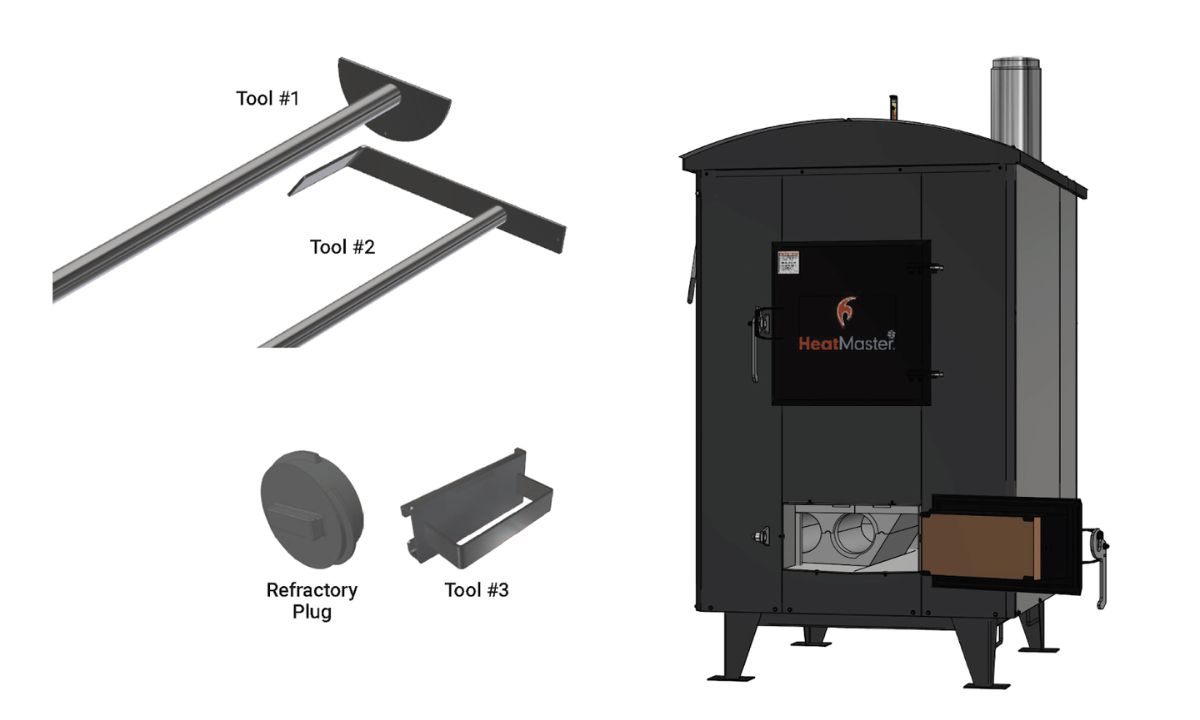
Depending on the severity of the buildup, you may need additional supplies such as a respirator, shop vac, or safety goggles for your annual cleaning.
2. Cool Down the Outdoor Furnace
After gathering your tools and safety equipment, cool down the furnace to prepare your outdoor furnace for yearly cleaning. Make sure that the fire is completely extinguished and that the unit has cooled down before you begin cleaning your furnace. Also, turn off all electrical power to the unit.
3. Remove Ash and Debris
Once the furnace is cooled, remove any ash or debris from the firebox. Use your HeatMasterss tools to clean the inside of the furnace, paying special attention to the areas of buildup. Start by using the cleaning tools to remove and scrape any loose debris from the surface of the boiler. Remove all ashes and excess creosote from the firebox, lower combustion chamber, heat exchange tubes, and chimney. Ashes should be placed in a metal container with a tight-fitting lid. The closed container should be placed on a noncombustible floor or on the ground well away from all combustible materials before final disposal. If the ashes are buried in soil or dispersed locally, they should be kept in a sealed container until all cinders have cooled.
4. Check for Creosote Build Up
When wood is burned slowly, it produces tar and other organic vapors, which combine with expelled moisture to form creosote. The chimney and chimney connector should be inspected at least twice a month during the heating season to determine if a creosote buildup has occurred. If creosote has accumulated, it should be removed to reduce the risk of a chimney fire.
5. Wash Down the Surface
A mild, non-abrasive cleanser can be used on painted surfaces, and a soft brush or sponge. Use a garden hose to wash away any dirt or grime that is clinging to the surface. Remember to take your time and be careful.
6. Check Gasket Seals and Covers
Check all of your outdoor furnace gasket seals to make sure they are sealing. To replace aging gaskets, remove the old seal and residue from the door, scuff the surface where the seal is placed with sandpaper, and re-apply high temp silicone. Lay fiberglass rope over silicone and let bond for at least 24 hours before using the furnace again. Also, make sure all covers and guards are securely in place and check hinges to ensure they are properly adjusted for a good seal.
7. Make Sure Water Treatment is Being Followed
One of the things that can damage your outdoor furnace is corrosion. This is why it’s important to follow a water treatment plan for your outdoor boiler. This will help extend the life of your furnace and protect it from corrosion.
Check your water pH every year. In fact, you must send in a water test annually to qualify for your warranty. Depending on the recommendations following your water test, add the appropriate amount of corrosion inhibitor. We recommend our HeatMasterss Wood Burning Furnace Water Treatment.
Below is a detailed breakdown of the recommended daily, weekly, monthly, and seasonal care and maintenance for your G Series outdoor wood furnace:
Daily Care of Your Outdoor Furnace
On a daily basis:
Visually inspect your furnace everyday, checking water levels and keeping an eye out for any potential issues like airleaks, excessive creosote buildup, water pooling on the ground, that the fan turns on when calling for heat.
- Ensure that all doors are closed and sealing properly. Adjust if necessary.
- Check for creosote buildup in the firebox and lower combustion chamber. Some creosote buildup along the walls, door jamb, and firebox door is normal.
- Check the water level.
- Clean heat exchange tubes by aggressively pushing and pulling the lever back and forth at least 5 times.
- Check to make sure the fan and controls are functioning properly. The fan should turn on when the furnace calls for heat. The control display should be functional and keep the water temperature within the cut-in and cut-out settings you have the control set to.
- Check for embers or ashes laying on the ground around the furnace and dispose of them.
- Make sure all covers and guards are securely in place.
- Make sure the Smokeless Loading Handle is closed. The handle should be angled towards the front of the furnace.
Weekly Care of Your Outdoor Furnace
On a weekly basis (or as needed):
- Using the service tools supplied, remove ash from the lower combustion refractory tubes, side, and rear chambers.
- Clean Tornado Combustion Chamber
- Open firebox door prior to opening lower chamber door
- Use the L-Shaped as rake to clean around chamber
- Be sure to clean thoroughly behind the refractory
- Note that spirals hang down
- Ash deflector on left side
- Remove refractory plug
- Use caution as very hot
- Do not drop in snow as may cause damage
- Use round head rake to clean out ash
- May appear plugged as naturally builds up at front
- Mostly self cleaning
- Clean left side of refractory
- Should be able to clean with round head rake without removing corner deflector
- Defector may be removed to make cleaning easier. Be sure to re-install correctly as this protects the door.
- Dispose of ashes in a metal container away from the stove and wood pile.
Monthly Care of Your Outdoor Furnace
On a monthly basis:
- Depending on the type and quality of wood being used, ash removal from the firebox may be necessary. For optimal performance, the ash bed in the firebox should not exceed 6-8”. If you are burning a wood fuel that leaves quite a bit of ash you may need to clean your firebox out every 2-4 weeks to get optimal performance.
- Ash should never be allowed to buildup above air channels
- Move coals to side and scoop out ash
- Move coals back over and clean other side
- Always dispose of ash safely
- Check the fan motor and wheel for creosote buildup. The motor and wheel can be easily removed by unplugging the wires to the fan and loosening the nuts on the stainless steel plate.
- Remove fan
- Clean thoroughly
- Ensure fan spins freely
- Inspect for creosote buildup in chimney
- Inspect air channels on sides of firebox for creosote buildup and air blockage
- Clean Upper Access above Heat Exchange Tubes
- Remove access panel
- Buildup of light ash is normal
- Scrape and/or vacuum to remove
- If there is a lot of wet creosote, troubleshoot for air blockage
- Test spiral turbulators
Seasonal Care of Your Outdoor Furnace
On a seasonal basis:
- Remove all ashes and excess creosote from the firebox, lower combustion chamber, heat exchanger tubes and chimney.
- Check all gasket seals to make sure they’re sealing. To replace, remove the old seal and residue from the door, scuff the surface where the seal is placed with sandpaper and re-apply high temp silicone. Lay fiberglass rope over the silicone and let bond for at least 24 hours before using the furnace again.
- Cover the chimney and crack open the bottom door enough to allow air movement and reduction of condensation within the firebox.
- Make sure your water tank is full and have your water treatment tested and adjusted to manufacturer’s specifications.
- Send in water sample now or at start up in fall
- If necessary, adjust the hinges on each side of the doors to maintain a good seal.
- Scrape out excess creosote, especially around doors
- Clean upper rear access
- Clean fan assembly
- Pumps can be turned off or left running during the off season
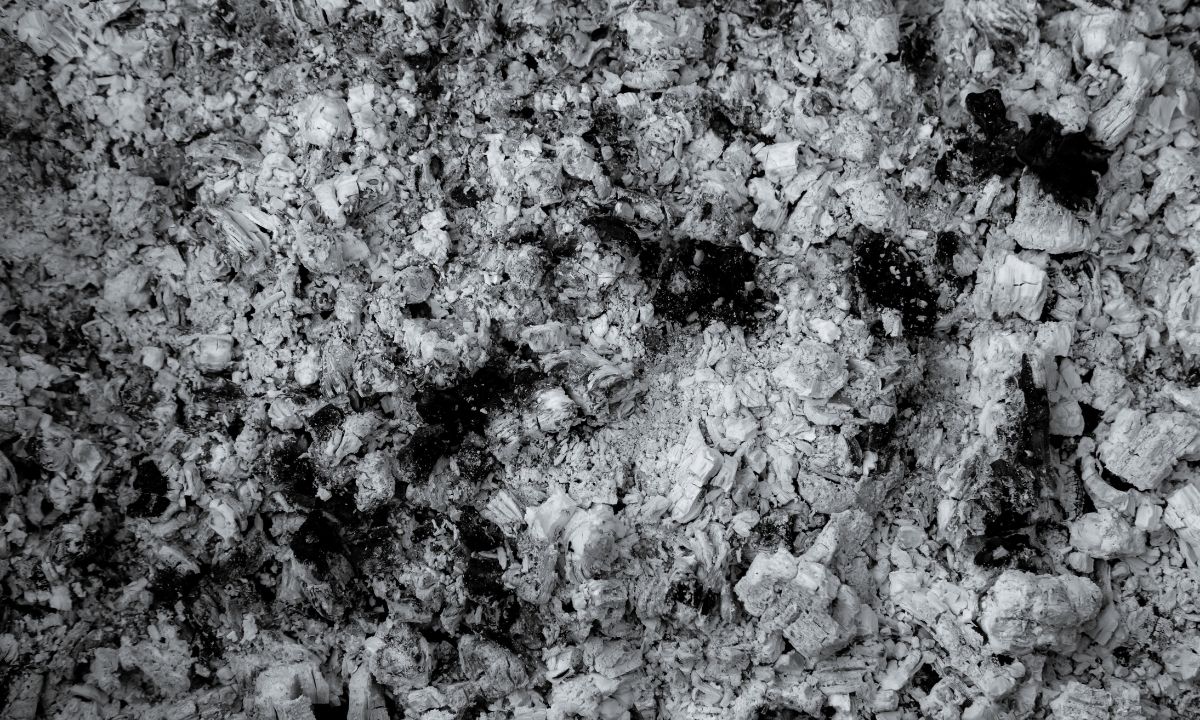
The HeatMasterSS Advantage
An outdoor furnace is a long-term investment in the independence and peace of mind your family deserves. Sometimes cleaning your outdoor boiler isn’t enough, and you need help to keep your furnace maintained and running for decades to come. HeatMasterss experts can help.
HeatMasterss is a family-owned company that has been manufacturing outdoor furnaces for over 20 years. Our mission is simple; help families achieve heating independence and save money.
If you have any questions or want to learn more, we’d love to hear from you today!
